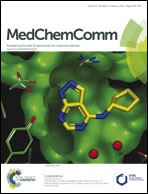Discovery of acrylonitrile-based small molecules active against Haemonchus contortus†
Abstract
We report the discovery of a series of acrylonitrile-containing molecules and α-amino amides which cause 99–100% lethality in H. contortus. Of the 22 acrylonitrile analogues investigated, the most active were 2-cyano-3-[1-(3-dimethylaminopropyl)-2-methyl-1H-indol-3-yl]-N-hexylacrylamide (13a), 2-cyano-3-[1(2-dimethylaminoethyl)-2-methyl-1H-indol-3-yl]-N-hexylacrylamide (13b), 2-cyano-3-{4-[3-(dimethylamino)propoxy]phenyl}-N-octylacrylamide (21), and 2-cyano-3-{1-[3-(dimethylamino)propyl]-1H-pyrrol-2-yl}-N-octylacrylamide (22) with each displaying LD50 values <15 μM whilst the α-amino amide methyl-2-[2-(2-benzoylphenylamino)-2-(4-methoxyphenyl)acetamido]acetate (12a) had an LD50 value of 10 μM. A cytotoxicity screen of the acrylonitrile analogues (13a, 13b, 21 and 22) against nine cancer cell lines indicated modest to high cytotoxicity. In contrast, the α-amino amide 12a displayed very low cytotoxicity, with a maximum of ∼30% cell death at 25 μM (A2780, an ovarian carcinoma derived cell line) and with a mean of 11% cell death across all cell lines evaluated. Thus, 12a is considered a promising lead candidate for the development of a new anthelmintic.


 Please wait while we load your content...
Please wait while we load your content...